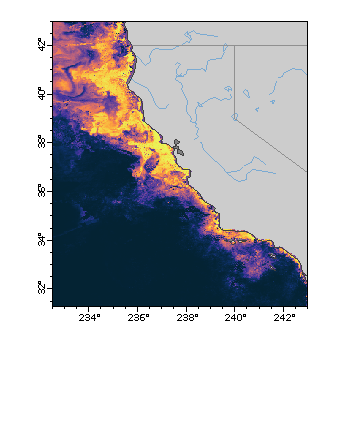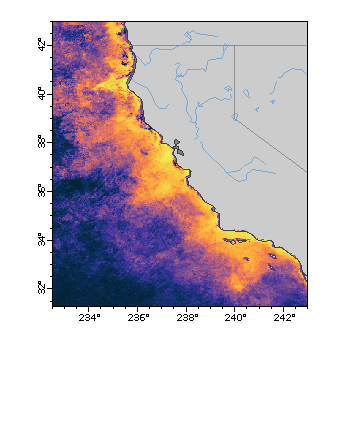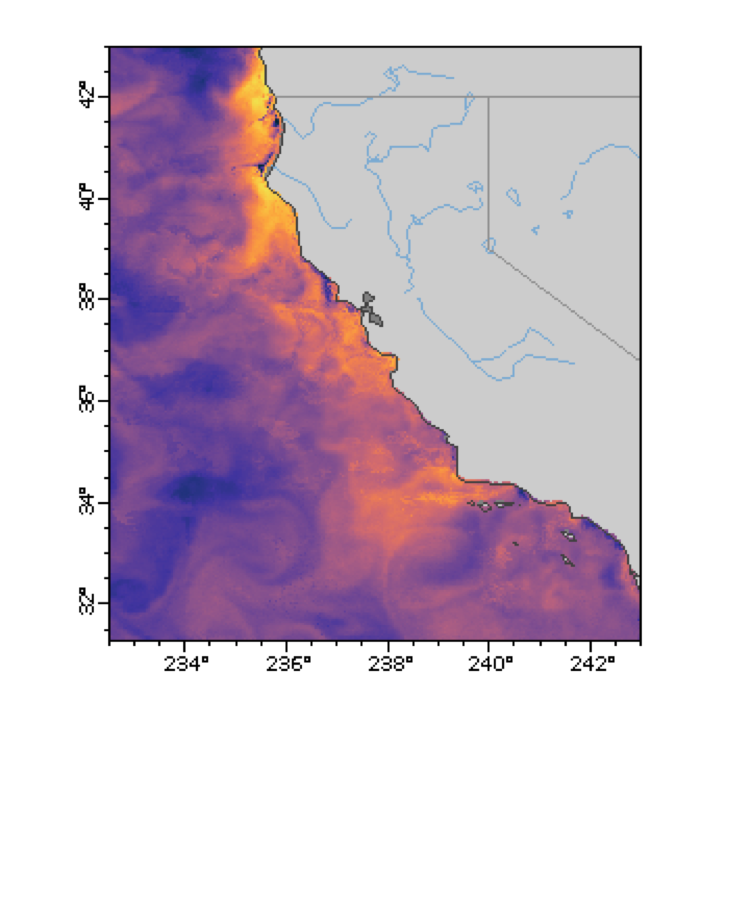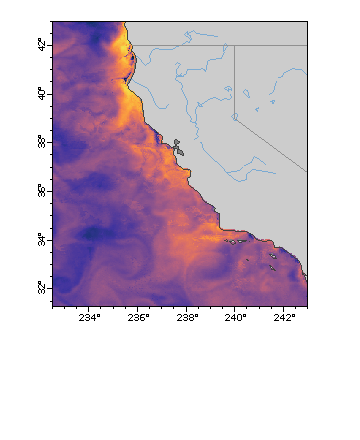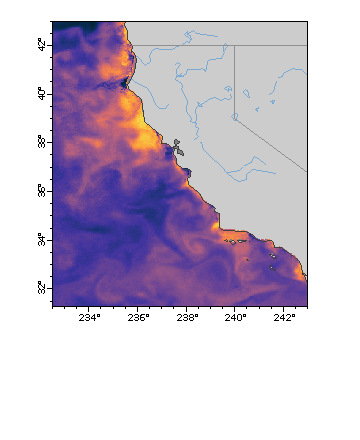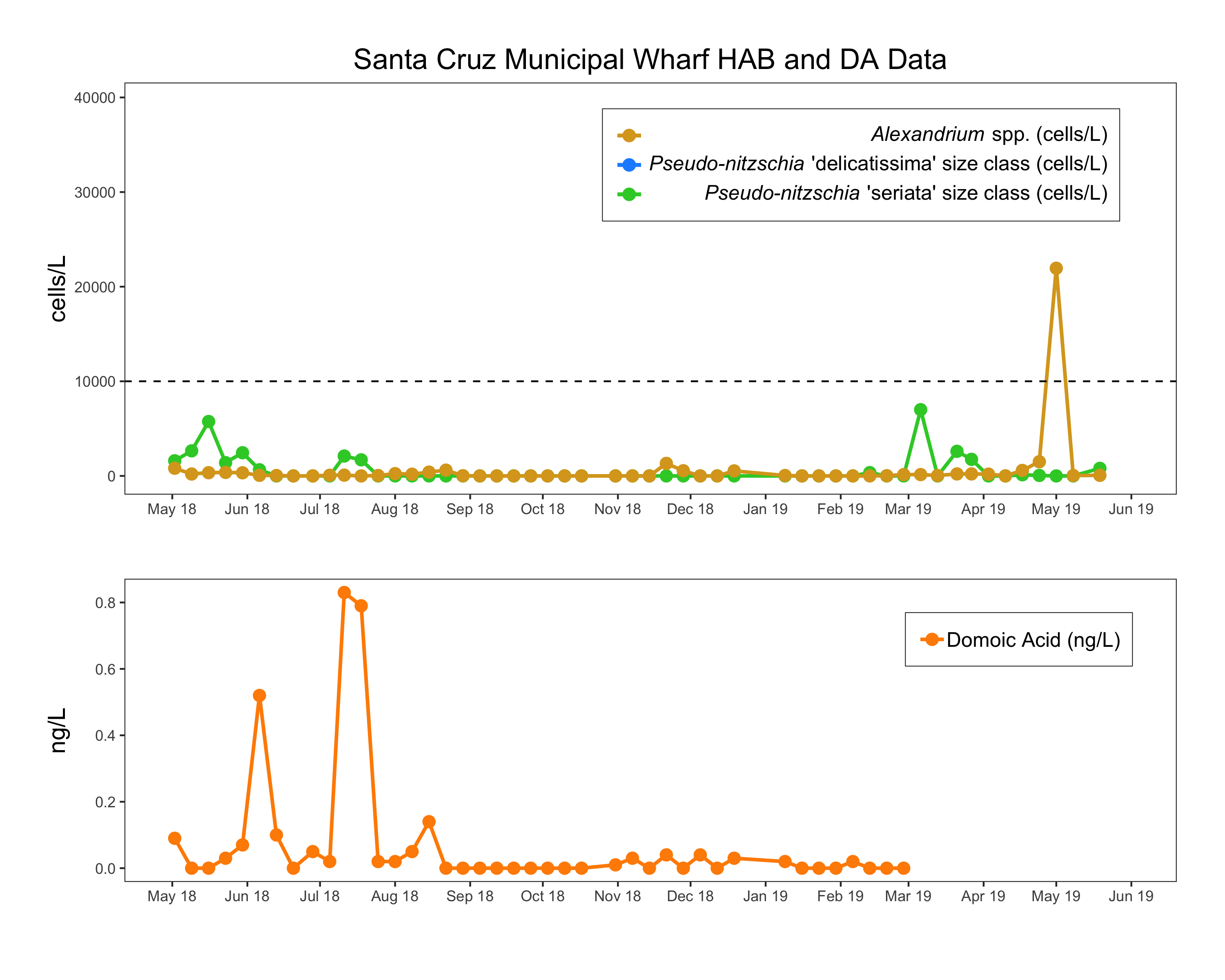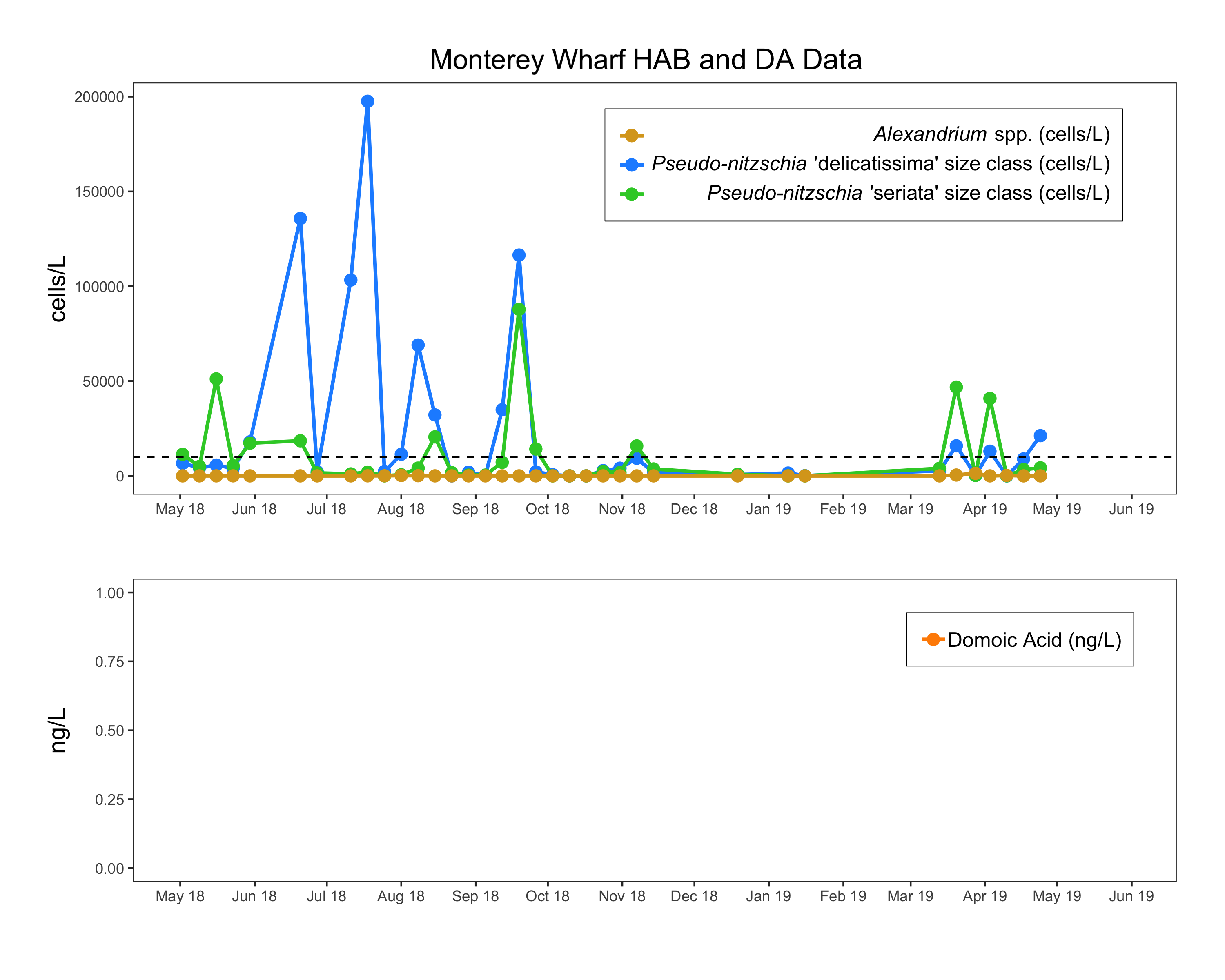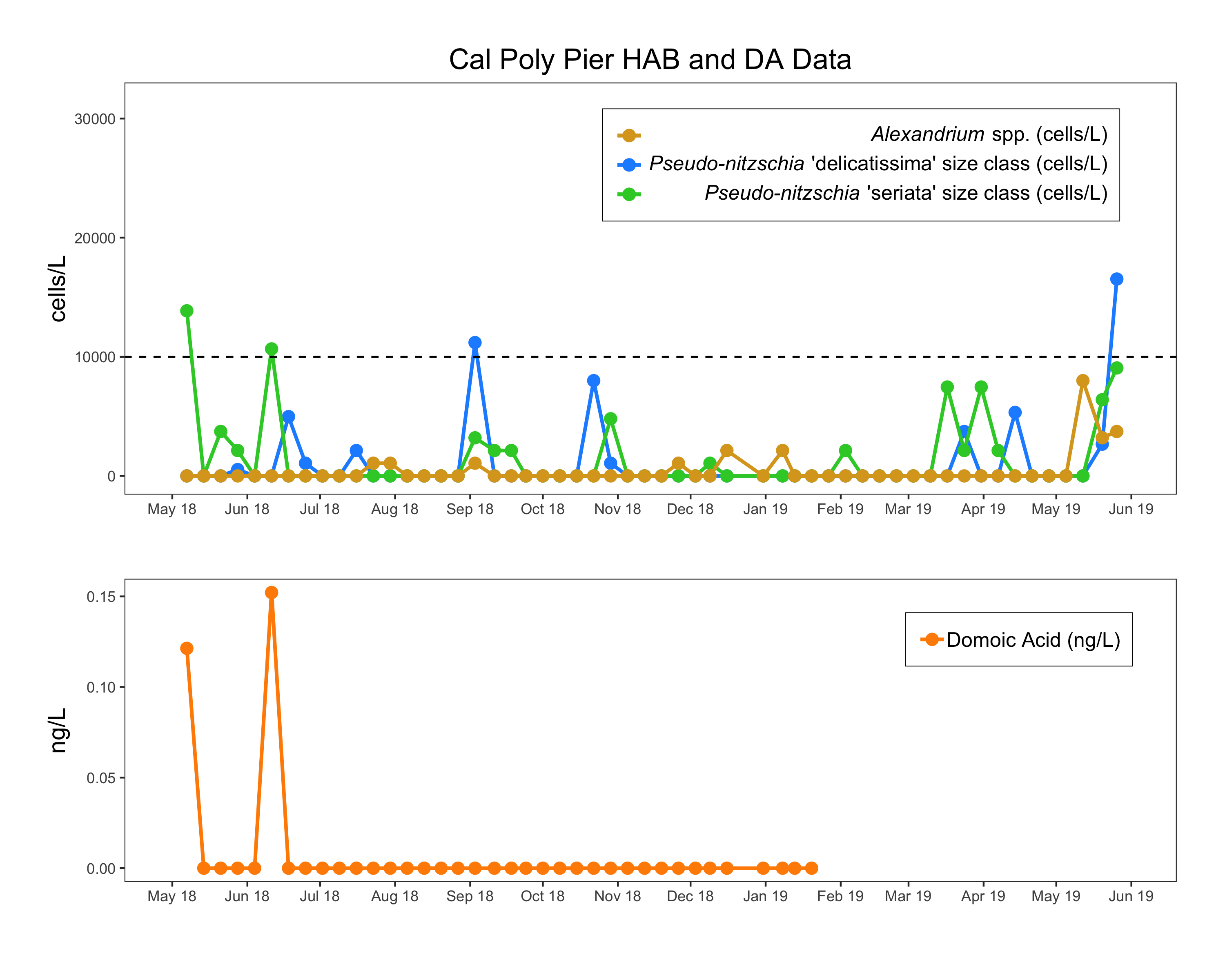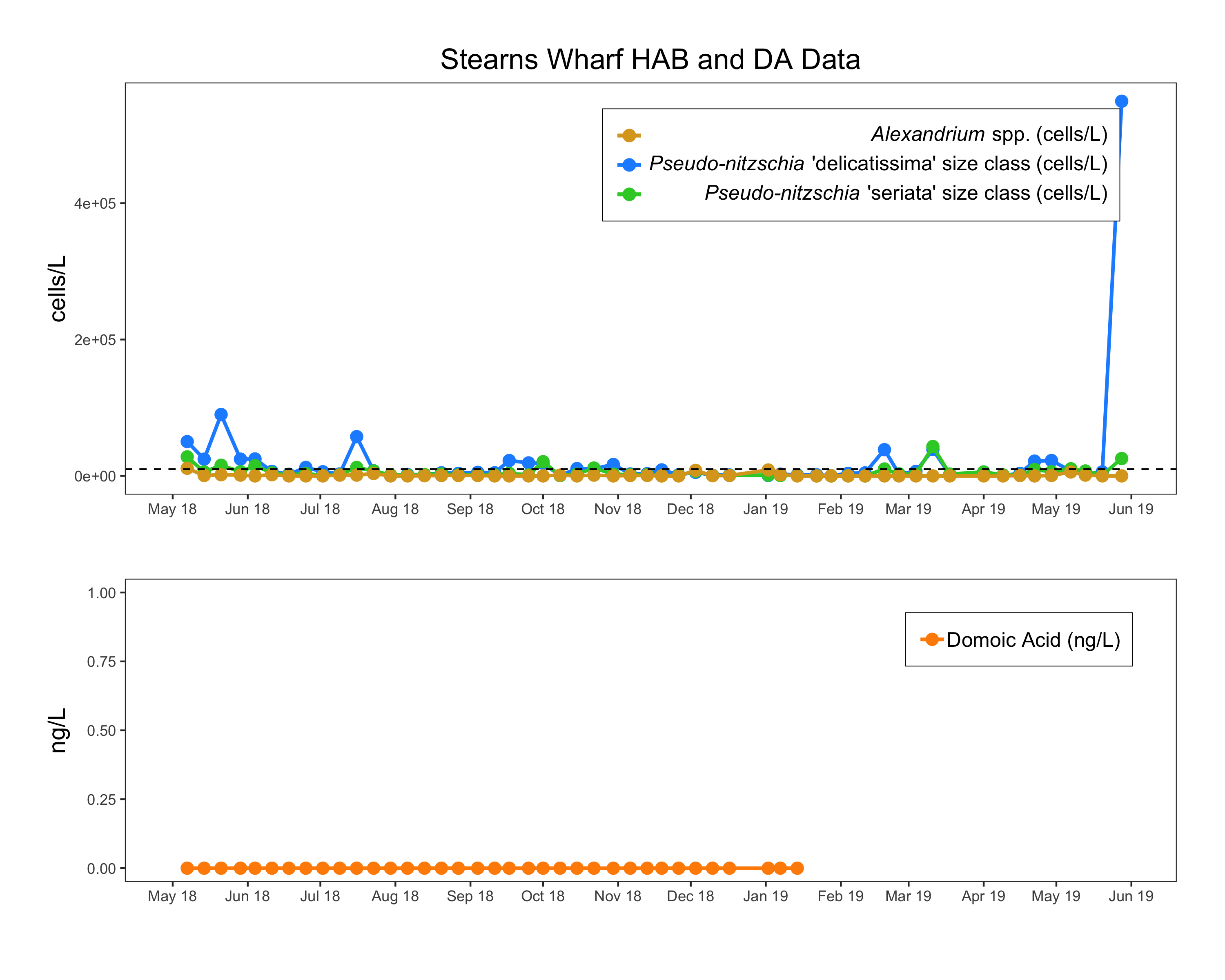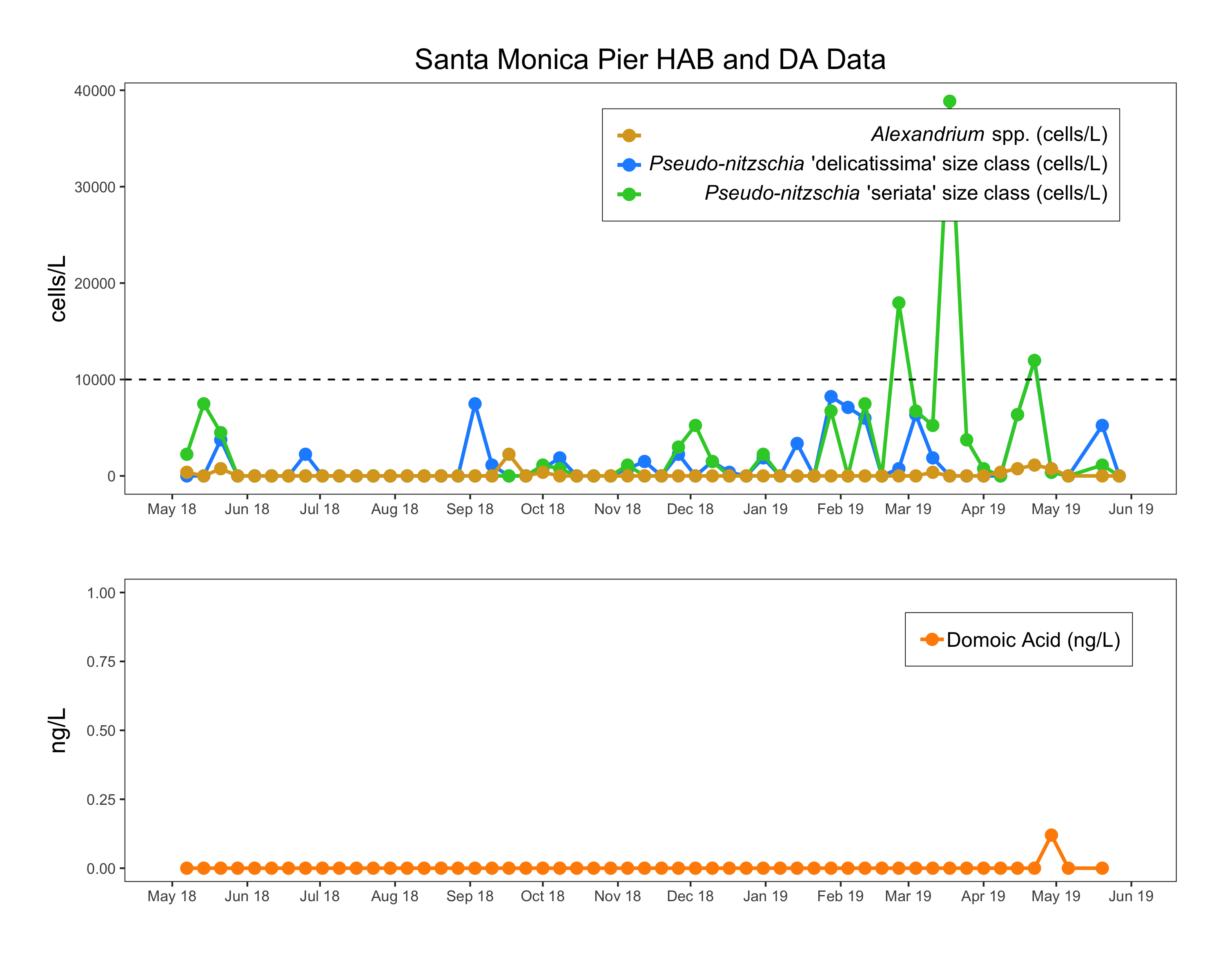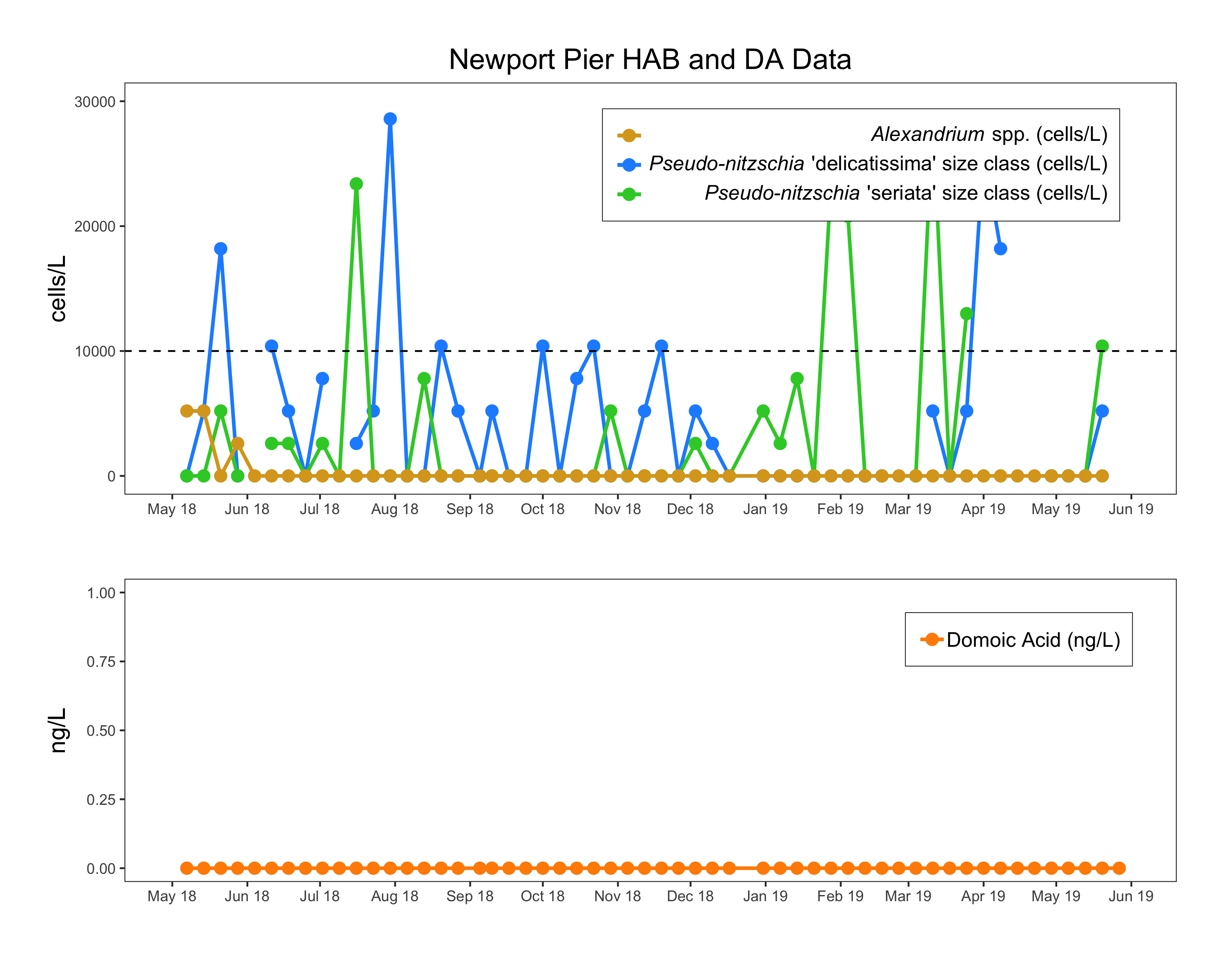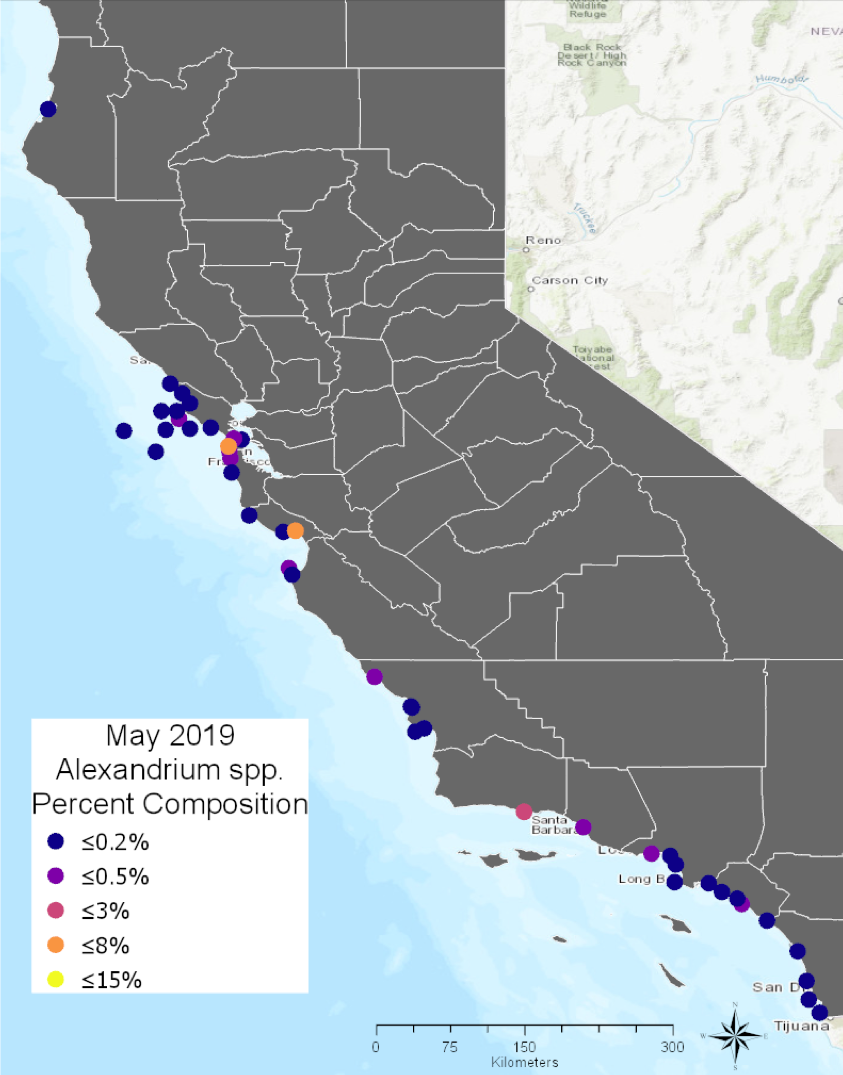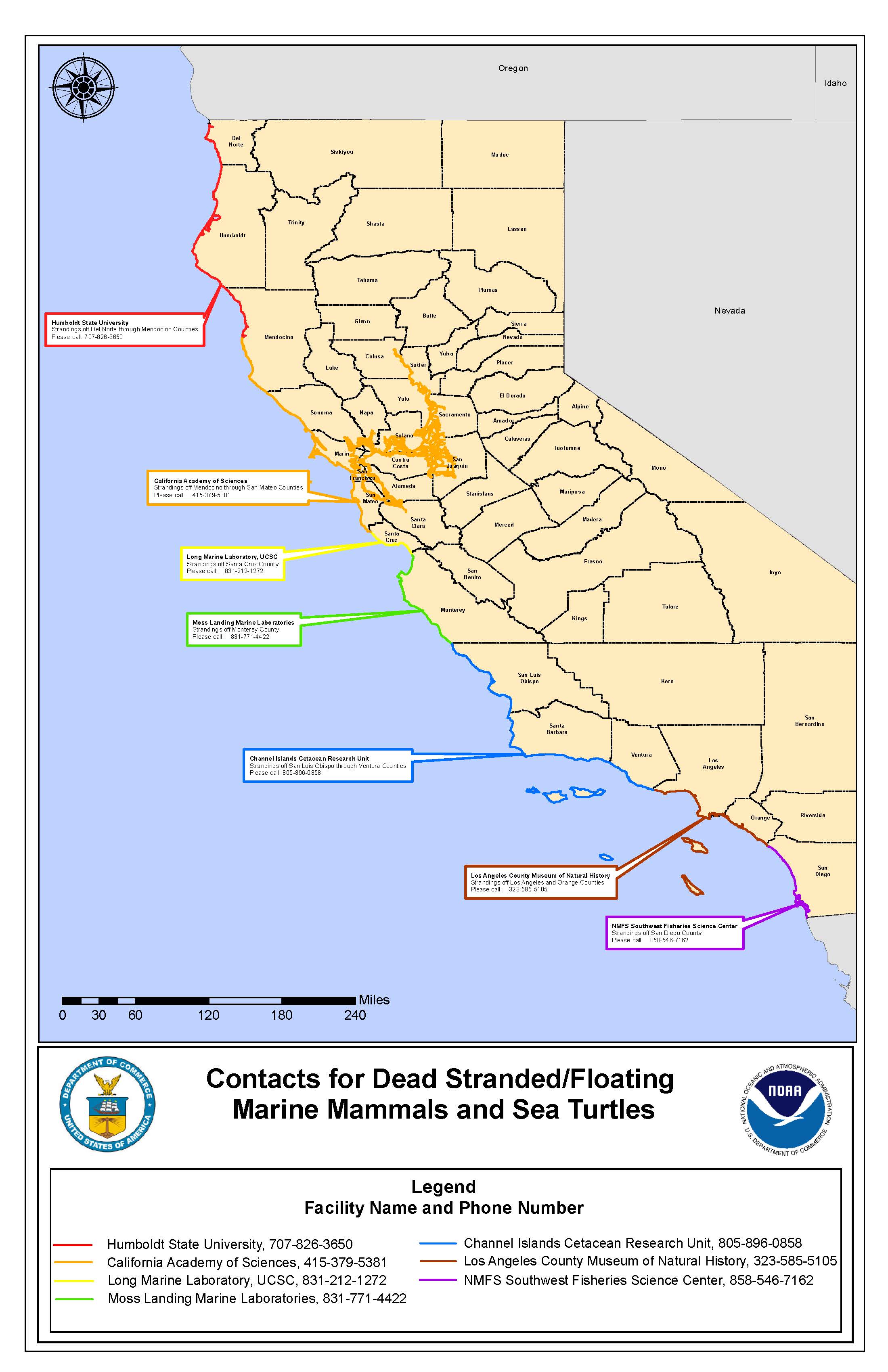Pseudo-nitzschia and Domoic Acid Predictions- C-HARM tells us where conditions are suitable for Pseudo-nitzschia spp. (all size classes) to grow well and where they might be more likely to produce domoic acid (DA). C-HARM also tells us where DA might be more likely to occur at high levels. For May, we show the shift from the beginning of the month to the end, as multiple foci of high DA activity started to emerge in central CA and in southern CA, especially in the Los Angeles and Orange County areas. C-HARM appears to capture this expansion of not only Pseudo-nitzschia growth potential but also DA production as the probabilities of both Pseudo-nitzschia abundance and particulate DA increased in those focal regions over the course of the month. HABMAP observations of Pseudo-nitzschia spp. abundance indicate bloom conditions from southern Monterey Bay to Newport Beach Pier (no observations posted currently for Scripps Pier). One feature of this rise is that the proportion of "seriata" (toxigenic) relative to "delicatissima" (non-toxigenic) size-classes increases as we move south. This is consistent with the cluster of suspected DA-related animal strandings in the Los Angeles and Orange County areas at the end of May. However, strandings were also noted in central CA and in the San Diego area. Interestingly though, for the sites where DA samples have already been processed, there is no spike in DA observed at Newport Beach Pier in Orange County during May. Elevated DA is only seen at Santa Monica Pier. CDPH volunteer sampling in May captured the greatest increases in Pseudo-nitzschia percent composition at Santa Cruz, Santa Barbara Channel, Los Angeles, and San Diego sites. Observational discrepancies are expected given the extreme heterogeneity in phytoplankton composition patterns and toxin production across nearshore sites, which also vary with respect to the offshore environment.
Alexandrium - HABMAP records for Alexandrium at pier sites show the unexpected and perhaps unprecedented record for Santa Cruz Wharf in May 2019, when Alexandrium spp. abundance shot to 25,000 cells/L in early May. This alerted CDPH to sample more mussels to analyze for PSP. The mussels collected had PSP levels greater than 80 µg/100g, which resulted in the CDPH issuing a health advisory on May 10th to not eat sport-harvested mussels, clams or scallops in Santa Cruz County due to PSP toxins. CDPH later recorded a similar spike outside San Francisco Bay.
HABMAP Monitoring Sites
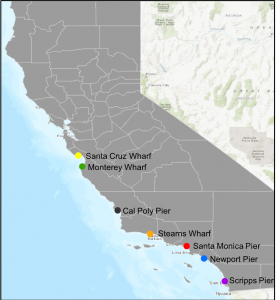
Note that data for some stations are not shown because they are not yet recorded in the public HABMAP archive.
Differentiating Pseudo-nitzschia species by light microscopy is difficult. For this reason, Pseudo-nitzschia "seriata" does not refer to an actual species but rather the larger size class of Pseudo-nitzschia, which is generally a more toxigenic group of species. Alternatively, Pseudo-nitzschia "delicatissima" refers to the smaller size class that is generally non-toxigenic. The dashed line on the plots demarcates the 10,000 cells/L "bloom" threshold designated here for Pseudo-nitzschia populations only.
Santa Cruz Wharf
Water samples were collected five times at Santa Cruz Municipal Wharf in the month of May. Pseudo-nitzschia seriata group was detected below bloom levels and Alexandrium spp. were detected above bloom levels on May 1st. Domoic Acid results are not yet available for the month of May.
Santa Cruz Municipal Wharf does not measure for Pseudo-nitzschia delicatissima group.
Cal Poly Pier
Water samples were collected at Cal Poly Pier four times in the month of May. Pseudo-nitzschia seriata group and Pseudo-nitzschia delicatissima group were not detected in any water samples. Alexandrium spp. were detected at bloom levels in three of the four samples. Domoic Acid results are not yet available for the month of May.
Stearns Wharf
Water samples were collected at Stearns Wharf four times in the month of May. Pseudo-nitzschia delicatissima group and Pseudo-nitzschia seriata group were detected above bloom levels throughout the month of May and Alexandrium spp. were detected above bloom levels on May 7th and 13th. Domoic Acid results are not yet available for the month of May.
Santa Monica Pier
Water samples were collected at Santa Monica Pier three times in the month of May. Pseudo-nitzschia delicatissima group and Pseudo-nitzschia seriata group were detected above bloom levels on May 20th. Alexandrium spp. were not detected in any samples. Domoic Acid results are not yet available for the month of May.
Newport Beach Pier
Water samples were collected at Newport Beach Pier four times in the month of May. Pseudo-nitzschia delicatissima group and Pseudo-nitzschia seriata group were detected above bloom levels on May 20th and Alexandrium spp. were not detected in any of the samples. Domoic Acid was not detected in any of samples in the month of May.
Scripps Pier
Scripps Pier Pseudo-nitzschia spp., Alexandrium spp., and domoic acid results are not yet available at this time.
CDPH observations for Pseudo-nitzschia spp. and Alexandrium spp.
From 1-31 May 2019, water samples were collected by volunteers and sent to the California Department of Public Health (CDPH) for analysis. Pseudo-nitzschia spp. were detected in 64 of the 104 samples. Pseudo-nitzschia spp. was recorded at Abundance density levels in two of the samples: May 29th at Santa Cruz Pier (65% composition) and on May 25th at Belmont Pier (50% composition). Alexandrium spp. were detected in 21 of 71 samples in the month of May with the highest percent composition of 15% on May 1st at Santa Cruz Pier. You can also view CDPH weekly map layers of Pseudo-nitzschia and Alexandrium here.
Data are provided by the California Department of Public Health, Environmental Management Branch.
CDPH and OEHHA Health Advisories
The California Department of Public Health (CDPH) issued a health advisory on May 10th to not eat sport-harvested mussels, clams or scallops in Santa Cruz County due to PSP toxins. The safety notification is in addition to the annual mussel quarantine starting May 1st. On June 7th, CDPH also released a shellfish safety notification for sport-harvest bivalve shellfish from San Luis Obispo and Santa Barbara Counties due to dangerous levels of paralytic shellfish poisoning (PSP) toxins detected in mussels.
For the latest closures and updates, please visit the CDFW Health Advisories page as a central location of information related to CDPH and/or OEHHA health advisories.
Domoic acid (DA) is a potent neurotoxin produced by some diatom species of the genus Pseudo-nitzschia. Species exposed to DA can result in seizures, epilepsy, cardiomyopathy, and death depending upon the ingested dose. DA toxicosis commonly occurs in California Sea Lions (Zalophus Californianus), presumably due to a combination of foraging behavior and seasonal movements. The Marine Mammal Center (TMMC), the California Wildlife Center, the Marine Mammal Care Center Los Angeles (MMCC-LA), Marine Animal Rescue, the Pacific Marine Mammal Center (PMMC), and SeaWorld act like an emergency room by working to rescue and rehabilitate sick and injured marine mammals, seabirds, and sea turtles.
TMMC, Ca Wildlife Center, MMCC-LA, Marine Animal Rescue, and SeaWorld recorded a total of six sea lion strandings presenting with symptoms of domoic acid toxicosis in the month of May.
No DA toxicosis cases have been reported by the Pacific Marine Mammal Center in May 2019.
May marine mammal and seabird strandings suspected due to DA toxicosis occurred at the following locations:
- May 18th, 2019 - California Sea Lion stranded at Torrey Pines State Beach, La Jolla, San Diego County - SeaWorld
- May 19th, 2019 - California Sea Lion stranded at Doran Beach Regional Park, Bodega Bay, Sonoma County - TMMC
- May 27th, 2019 - California Sea Lion stranded at Montana de Oro State Park, Los Osos, San Luis Obispo County - TMMC
- May 28th, 2019 - California Sea Lion stranded at Leo Carillo State Beach, Malibu, Los Angeles County - CA Wildlife Center
- May 31st, 2019 - California Sea Lion stranded at Will Rogers State Beach, Venice, Los Angeles County - MMCC-LA
- May 31st, 2019 - California Sea Lion stranded at Venice Beach, Venice, Los Angeles County - MMCC-LA
Who to Call if you find a LIVE stranded marine animal
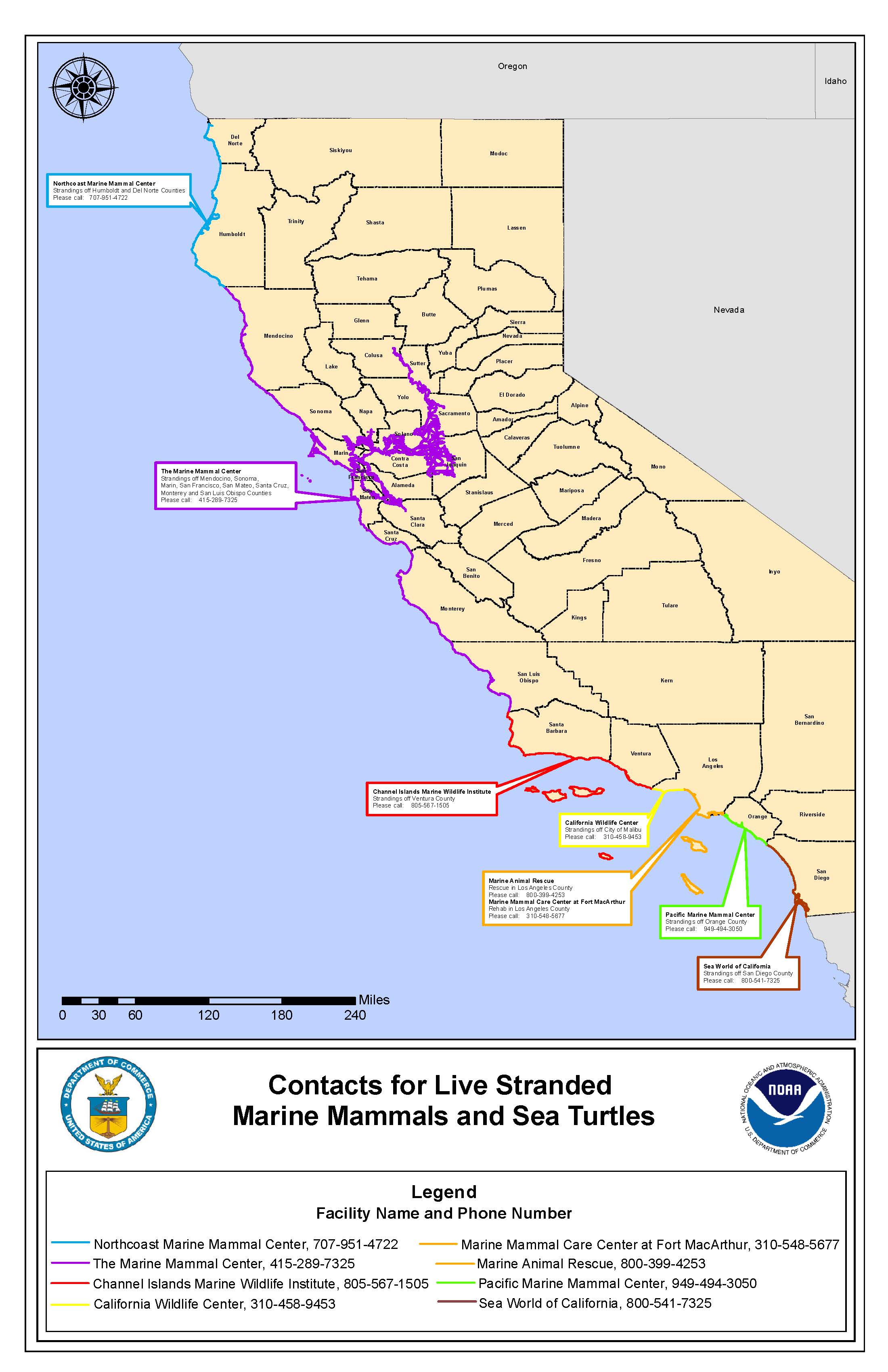
Who to call if you find a LIVE stranded marine mammal or sea turtle
Sea World of California (800) 541-7325
- San Diego County
Pacific Marine Mammal Center (949) 494-3050
- Orange County
Marine Animal Rescue (800) 399-4253 and California Wildlife Center (310) 458-9453
- Los Angeles County
Channel Islands Marine Wildlife Institute (805) 567-1505
- Santa Barbara County
- Ventura County
The Marine Mammal Center (415) 289-7325
- Alameda County
- Contra Costa County
- Marin County
- Mendocino County
- Monterey County
- Napa County
- Sacramento County
- San Francisco County
- San Luis Obispo
- San Mateo County
- Santa Cruz County
- Sonoma County
Northcoast Marine Mammal Center (707) 951-4722
- Del Norte County
- Humboldt County

